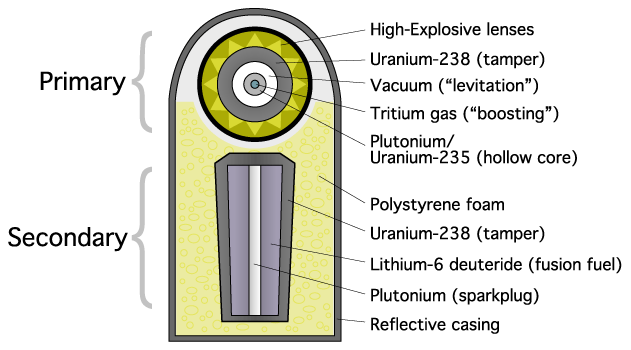Nuclear fusion on the other had seems to be the opposite, instead of using a toxic material like uranium 235 and controlling the reaction process by exposing the control rods to the core reactor. The control rods are cadmium and boron and they absorb the the neutrons, which is the key factor of cascading effect when splitting the uranium 235 atom.
Theory is that when you collide light materials like Hydrogen or Isotopes of Hydrogen (hydrogen with an extra neutron or two) The heat produced from that interaction is much more then the energy that went into producing those conditions. The reality though is difficult the only current man made method to make a fusion reaction is by using a fission explosion as a primary to force Tritium gas and Lithium -6 (fusion fuel) to be slammed together with in a Xray reflective casing (secondary).
Thermonuclear fusion could possibly happen if matter is sufficiently hated into a plasma, the fusion reaction due to collisions with extreme thermal kinetic energies of the particles. This process is called Thermonuclear fusion. Magnetic confinement is when electrically charge particles will follow magnetic field lines. The fusion fuel can therefore be trapped using a strong magnetic field. A variety of magnetic configuration exist, including the toroidal shape ( donut shape) and magnetic mirror. The pinch concept is based on the concept that plasma are electrically conducting. If you run a current through the plasma, the field will, according to lenz's Law creating inward directed force that causes the plasma to collapse inward. This will raise its density and more current will give more denser plasma increasing the inward force leading a chain reaction. If conditions are correct this will lead to an environment just right for fusion to start. The difficult part is to get current into the plasma, this is solved by inducing the current in the plasma by induction from an external magnet, which produces the field that squeezes it self.
Inertial fusion involves spherically convergent implosions of 100 micron diameter, driven by 1 mega joule bursts of energy delivered in 1 nanosecond. They require enormous laser beam or particle beam energies to rise the temperature and conditions for reaction.
other methods of cold fusion and sonoluminescence prove unfruitful using current pass through a jar of heavy water with palladium electrode. Or using intense sound waves induces a gaseous cavity within a liquid to collapse quickly both methods are discredited, due to the fact the neutrons that was to be emitted from reactions were not from actual reaction but from the background radiation of the sun.
Most of the methods of nuclear fusion I read about seem to forget that gravity provides a stable element in maintaining a constant reaction. Squeezing plasma by magnetic fields is like holding something intangible, when the reaction starts eventually it will touch the sides of the reactor and cool down. This whole idea of recreating the suns power is a pipe dream which is significantly more expensive then fission. Granted there is a flaw in the current technology of fission reactor. Though Thorium fission reactors seem to be a better system, there still will be a waste product. There are optimists who think that fusion reactors might be around the corner, wait around 20 or 30 years for someone to think up a way to squeeze a ball of plasma so hot and dense that it won't touch the sides of the reactor wall. And then harness that heat for power to sustain the system and have enough to supply a city or two, is an incredible task which might be too much. With the level of technology we can smash together atoms even find subatomic particles that will prove a theory. But we haven't been able to create gravity or a container that will hold a plasma ball for sustained fusion. Beside making the reactor chamber hotter research has taken us so far but I seriously doubt, there are any more improvements we can do.




I find it fascinating how scientists continue to explore different approaches to achieve nuclear fusion.
ReplyDelete